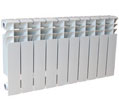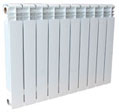

Add.: No 5558 Chuansha Road, Pudong Discrict, Shanghai, China
Tel.: +86-21-60346873
+86-21-60346873
Fax: +86-21-60346873
Zip Code: 321200
E-mail: landy.industry20@gmail.com
http: //www.biradiator.com
How to Choose Radiators ?
Tips in purchasing radiators
1. Choose those produced by renowned corporations.
2. Before purchasing, it is necessary to know about the water quality of your residential areas, the heating models of heating system (such as by household or residential district), and whether the heating system is open or closed. Make sure of the using conditions of products before purchasing, for example, some companies will note clearly in the instructions that their radiators apply to closed system, neutral recycling water and that they must be filled with water for maintenance during the non-heating period.
3. When you buy the radiator of one manufacturer, it is better to buy accessory from the same manufacturer to avoid accidents during installation or use caused by the discordance bhttpeen accessory from other manufacturers and the radiators and to prevent the difficulty of defining the responsibility when an accident does occur.
4. At present, corporations take measures to guarantee radiator's resistance against corrosion independently, so it is a must to check whether their technology in this regard is up to the standards and ask stores to show correspondent quality check report. Never buy radiators whose conformity certificates contain no information about the products' radiation amount.
5. Ask designated personnel from the estate management department or the manufacturer for installation and maintenance.
The amount of heat radiation should be set in accordance to the area.
It is always a puzzling question whether to choose a plate radiator or a column one. They both radiate heat through convection and radiation. In terms of radiation model, it is completed by the spread of electromagnetic waves in space. It has a relatively small spreading scope. Generally speaking, only within 1 meter around the radiator can heat be felt. However, the convection model is done by means of the recycling flowing of hot and cold air; as a result, it has a broader and evener spreading scope. Thanks to its structure, the plate radiator can produce a sucking force when it is used, the so-called chimney effect, which can enhance compulsive convective effect and make heating more comfortable. This advantage is unsurpassed by the column radiator.
There is some ground for this question---rooms with a small area, such as bathrooms, can choose a column radiator because it can be hung on walls to save room and towels and other small objects can hang on its horizontal bar; as to larger rooms, it is advisable to buy a plate radiator, for its inside has more convection plates so that the best radiation effect can be achieved in the shortest time with the combination of convection and radiation. Nowadays, completely convective radiator with a good radiation effect offers a better choice for rooms. Besides, they are also suitable for places which used to be inconvenient to install radiators like French doors so as to save space. The corrosion resistance problem of radiators which once troubled people in the past has been basically settled, but the amount of heat radiation arises as a new concern. Some steel radiators such as Zehnder and Nuociss took the lead in solving the question of resisting corrosion. Retting, a European radiator corporation, has especially researched and developed a CR-I series of stainless steel radiators which resist corrosion for heating systems in China, becoming a high-end product among convective radiators on the market at present. The major materials of this series of radiators, including stainless steel tubes, aluminum fins, gunbrass connection parts, are all imported from Europe directly. As a result, these improvements about this CR-I series of stainless steel radiators lay a solid foundation for excellent heat radiation effects. Stainless steel radiators which resist corrosion from Zehnder, oval-shaped steel radiators from Nuociss and copper-aluminum alloy convective radiators from Sayeah all have high quality and safety guarantee.
-

- Die Casting Aluminum Radiator
The major feature of die casting aluminum radiator is that the top of each radiation fin has a cast ventilation device and that different fins are connected by inscription. ...
-

- Bimetal Radiator
Bimetal radiator is a kind of synthetic radiator which adopts the wielding technology. All indicators of this bimetal radiator reach the departmental standards. ...
